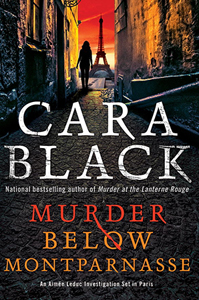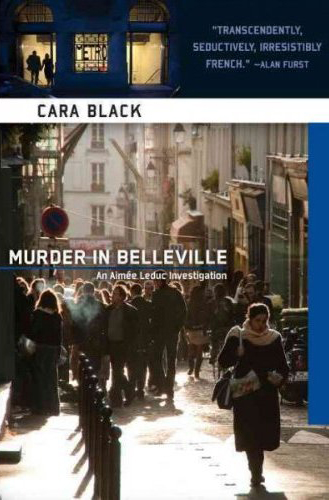Interview with Cara Black, author of Murder Below Montparnasse

- SUBSCRIBE
- ALREADY SUBSCRIBED?
BECOME A BONJOUR PARIS MEMBER
Gain full access to our collection of over 5,000 articles and bring the City of Light into your life. Just 60 USD per year.
Find out why you should become a member here.
Sign in
Fill in your credentials below.
 “Chamaret” waltzed into the Bonjour Paris chat room (yes, there were online chats each night) and, first thing, she asked what color the fire hydrants in Paris were. I didn’t know that night (rather, it was 3 a.m. French time), but I sure did the next day. The chat room’s participants felt a real sense of involvement and they were probably the nucleus of Cara Black’s, aka Chamaret’s, Francophile fans, who have followed her and her detective heroine Aimée Leduc through 13 arrondissements. And they’ll continue to follow her through all 20 if Cara, and of course Aimée, feel so inclined.
“Chamaret” waltzed into the Bonjour Paris chat room (yes, there were online chats each night) and, first thing, she asked what color the fire hydrants in Paris were. I didn’t know that night (rather, it was 3 a.m. French time), but I sure did the next day. The chat room’s participants felt a real sense of involvement and they were probably the nucleus of Cara Black’s, aka Chamaret’s, Francophile fans, who have followed her and her detective heroine Aimée Leduc through 13 arrondissements. And they’ll continue to follow her through all 20 if Cara, and of course Aimée, feel so inclined.
It’s incredibly hard for me to believe Cara Black has just published her thirteenth book—yes, the thirteenth book about Aimée Leduc, who lives and works in Paris.
Cara has been busy for nearly 20 years. The most recent book, Murder Below Montparnasse, is where Aimée Leduc finds herself immersed in the art world after one of her clients is murdered over a lost Modigliani painting. Aimée’s life isn’t confined exclusively to crime; there’s also a lot of intrigue and romance that never quite works out, as she unearths so many things during her travels throughout Paris.
Cara’s first book, Murder in the Marais, was published in 1999. Cara hoped it would simply be her first mystery. But, she was caught off guard when her publisher asked where the second one would take place. Well, it would have to be in Paris, bien sûr. And so she is working her way through the snail-shell of Paris.
 Because she was staying with friends in Belleville, that seemed like as good a place as any for the second book. Back then, the area was kind of dicey and it’s the only time Cara’s felt nervous while researching. She was in the midst of taking notes and drawing pictures of a storefront mosque when one of its inhabitants told her she wasn’t welcome. That’s the type of danger Aimée is always encountering and Cara freely admits Aimée is her alter ego. “She’s a fashionista, thinner, knows how to tie a scarf perfectly and is really computer savvy.” One reader describes Aimée as “never letting up and never dressing down.”
Because she was staying with friends in Belleville, that seemed like as good a place as any for the second book. Back then, the area was kind of dicey and it’s the only time Cara’s felt nervous while researching. She was in the midst of taking notes and drawing pictures of a storefront mosque when one of its inhabitants told her she wasn’t welcome. That’s the type of danger Aimée is always encountering and Cara freely admits Aimée is her alter ego. “She’s a fashionista, thinner, knows how to tie a scarf perfectly and is really computer savvy.” One reader describes Aimée as “never letting up and never dressing down.”
There’s no question that Cara lives vicariously through Aimée and frequently doesn’t know the outcome of the mystery until she’s well into a book because it must be “organic.” But, one thing that’s certain is that good always triumphs over evil and there will be resolution and some form of justice—which actually, is probably more American than French.
Cara didn’t anticipate Aimée, who’s only four years older now than she was in the first book, would become a fixture on the Parisian crime scene, much less think she’d be awarded the Médaille de la Ville de Paris. Now Cara’s publisher won’t hear of the high-energy detective leaving the City of Light even if Cara has the urge to go (temporarily) elsewhere.
Sitting down to talk with Cara recently on Skype brought back many memories. Perhaps it was only appropriate we were speaking via the Internet, because we first met in cyber space when Bonjour Paris was exclusively on AOL and we were all on incredibly slow dial-up modems. Subsequently, we’ve gotten together in Paris, Provence, San Francisco and Washington, D.C. Here’s some of what she told me during our interview.
 Karen: How much time to you spend in Paris?
Karen: How much time to you spend in Paris?
Cara: I come to Paris twice a year and stay at least a month. I stay with friends or during the past few years, I’ve kitty-sat in an apartment on the Canal St-Martin.
Karen: What do you first do when you arrive in Paris?
Cara: I always go to the Place des Vosges and touch the earth. I stay up all day, drink lots of espresso and throw myself into speaking French.
Karen: How do you research books?
Cara: I walk and take copious notes and research the subject and the areas as much as I can. I use libraries, archives and even phone books from 1998. But people are the most important component of my research. It’s really important to be invited into their homes (this isn’t always easy in France) and make personal contact. It’s essential to find the right people and ask the right questions.
When researching Murder below Montparnasse, Cara spent a great deal of time with “art cops,” was even allowed to see the vault where stolen art is stored. Cara also spoke with people from Interpol. Here are a few more of her thoughts and insights from the interview.
On Speaking French: Cara isn’t 100% fluent, although her French is much better now than when she began the Murder series. What Cara is finding however, is that the French are more willing and want to speak English so, as was the case with the “art cops,” they were one another’s language teachers.
On Clothes: Cara says she doesn’t buy clothes in Paris other than what she finds in second hand stores, brocantes and vide greniers. Oh, she does buy her socks at Monoprix. As a matter of fact, she’s quasi-wardrobe challenged and wears black most of the time.
On things she takes back to the U.S.: Cara is an old book and magazine collector and takes them home to San Francisco. She also goes the Marché St Quentin and buys vacuumed-packed cheeses, which she takes home in her suitcase. Her favorites are Brébis. She also brings home vacuum-packed Merguez sausages.
On living in Paris: “Sure, I’d love to split my time here as Diane Johnson, another San Francisco resident, does.” But Cara loves the Bay Area and doesn’t especially cherish being cold during February in Paris.
On changes she sees in Paris: Cara is fast to admit she misses the “village” feel of Paris. There used to always be a tabac, a bakery, a cheese store and a shoemaker. Now, banks have replaced too many corner stores. “There are banks everyplace you look.” Cara would rather drink coffee in a café than one at a French Starbucks.
On writing now versus then: It’s both success and a sign of the times that Cara feels more pressure to promote books and goes on frequent speaking tours. This takes time and some of the time is when Cara wishes she were writing. “It’s hard to juggle some of the demands when I feel I should be concentrating on the next book.”
Cara’s no slouch at social media and has an active Facebook page and a Twitter account. For that matter, Cara doesn’t seem any older than she did when we first met. Perhaps, she and Aimée share the “ageless” gene.
Murder below Montparnasse may be ordered here or you may also want to order one of Cara’s other books.
More in book, Cara Black, Diane Johnson, new book, Paris books, Paris Is for Murder


